IN THIS ISSUE
- On a pine snake's tail
- Whale rescue up close
- The fly that carpenter bees fear
- Mega-mom helps set sea turtle record
 Bryan Hudson, right, and Trent Blalock with the pine snake tracked at Russell WMA (Rick Lavender/DNR)
Less than two weeks after its return to Lake Russell Wildlife Management Area, a northern pine snake is already providing some of the insights hoped for when scientists released it July 12.
Bryan Hudson, a Clemson University doctoral student and co-founder of Project Pine Snake, has been tracking the nearly 6-foot-long snake via a radio transmitter surgically implanted in it.
“In July their movements seem more restricted,” Hudson said by email, “but he has been using a matrix of upland pine habitat thinned and burned by the U.S. Forest Service and DNR. He has been in a stump hole and a small mammal burrow, and spotted once moving through the pine forest.”
While not earth-shattering, such data is needed considering that northern pine snakes are so secretive and scarce in northeast Georgia. The big, nonvenomous snakes were once common in the region. Locals called them bull snakes. But they seldom see them anymore.
Already elusive, these snakes that spend most of their lives underground have become more rare. That’s largely because northeast Georgia’s open woodlands, farm fields and orchards – early successional habitats that suited the snakes – have given way to thick forest, roads and buildings.
At Lake Russell WMA, 17,300 acres of Chattahoochee National Forest near Cornelia, the DNR, Forest Service and other Georgia Plant Conservation Alliance members are using prescribed fire and thinning to restore patches of “prairie.” The work is benefiting rare plants, such as endangered smooth purple coneflower and Georgia aster, and rare animals, like Bachman’s sparrow and northern pine snake.
Hudson’s research, which DNR supports, is exploring northern pine snake populations and their habitat use. Of the four pine snake subspecies and species, the northern pine snake may be the least understood. Which is one reason it's listed as a conservation concern in Georgia’s State Wildlife Action Plan, DNR wildlife biologist Thomas Floyd said. “We just don’t know much about it.”
Hudson had been hunting for pine snakes in Habersham and Stephens counties since 2010 but had yet to see a live one. When DNR wildlife technician Trent Blalock called and said he “was looking at" a large one on Russell WMA, Hudson responded: “Don’t think! Grab that snake!”
A week later, with project supporters watching, Hudson asked Blalock to name the snake before it was released. “Russell,” Blalock answered with a grin.
Hudson said recently that Russell is now “living the subterranean life (and) loving areas managed with fire and canopy thinning.”
Top
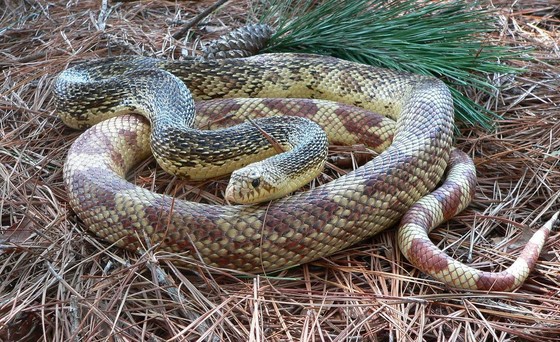 SIZING UP NORTHERN PINE SNAKES
- Heavy-bodied and up to 6 feet long.
- Tan, yellow or white, with dark blotches on back third, checkered pattern in the middle and darker mottling on the head.
- Range is patchy but reaches from open, upland forests in New Jersey to north Alabama.
- Built to burrow, with a pointed snout and prefrontal scales that help them dig more efficiently.
- Will blow loudly when scared (watch and listen). Will also vibrate tail.
WHAT YOU CAN DO
Top
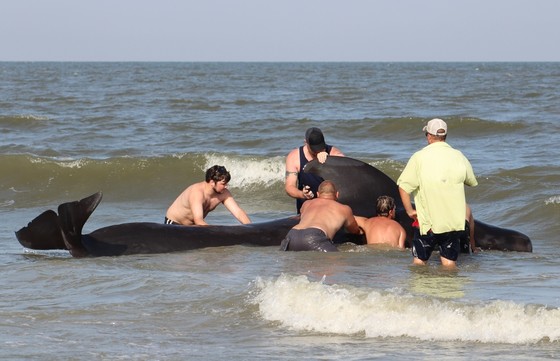 Stranded pilot whale on St. Simons (Jordan Chriqui/Coastal Blackwater Adventures)
Scores of beachgoers, lifeguards, local officials and DNR staff will not soon forget July 16.
Thanks to their work and a rising tide, a mass stranding of short-finned pilot whales that began about 6 p.m. on St. Simons Island’s East Beach ended with most of the pod of some 50 whales swimming back to sea. At least 20 stranded. Only three died.
Senior wildlife biologist Clay George, who coordinates DNR’s work with marine mammals, helped lead the response that long, chaotic evening.
He explained the incident – one of only three known mass strandings of pilot whales in Georgia since 1962 – in interviews with Jacksonville, Fla., stations and CBS News.
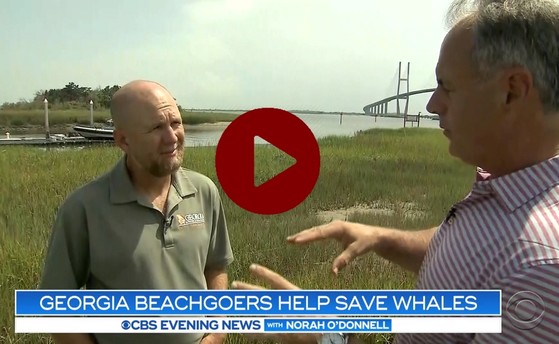 Glynn County beach manager Shawn Lentini said lifeguards first spotted the pod just after 5 p.m. near Gould’s Inlet, at the north end of East Beach. They thought they were heading out to sea.
But less than 45 minutes later, the lifeguards noticed people gathered in the surf just south of the Coast Guard Station. The whales were swimming into shore. Lentini phoned DNR game warden 1st Class Jay Bright, a longtime friend.
Bright’s advice: Try to keep the whales in the water, but watch their tails, be careful and don’t let people put themselves in danger.
Lifeguards and beachgoers began trying to push stranded whales -- massive animals weighing more than a ton -- into deeper water and keep others from the shallows, with Lentini keeping an eye on the group’s safety. The incoming tide was key, he said. “Had it been low tide, I don’t think we would have been able to save any.”
DNR staff arrived within minutes and began managing the rescue effort. The watching crowd grew to hundreds. Media followed. News of the stranding would circulate worldwide.
Yet what was a headline for most is vivid memory for Lentini. “It’s something I never expected to experience,” he said.
Top
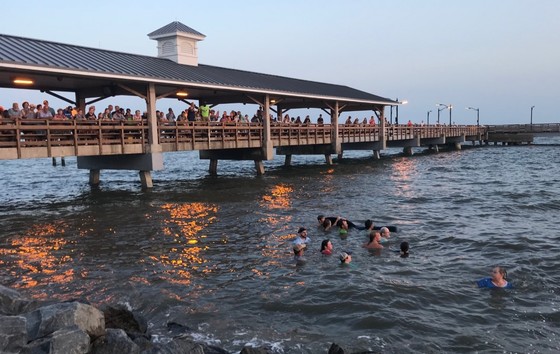 As evening falls, DNR and volunteers move a stranded whale past the St. Simons pier. (Tyler Jones/DNR)
THE LATEST
Of the three adult males that died, initial necropsy findings revealed no obvious signs of human interaction that might have caused or contributed to their stranding. Some mild signs of disease were noted. But such findings are common in wild, adult animals. Further analysis is pending.
At least 47 whales were photographed swimming from St. Simons toward deeper water July 17. On July 21, a pod of pilot whales was seen offshore of Florida, 140 miles away. A video by a charter angler shows a dorsal fin that looks similar to the fin of one of the St. Simons whales. But that identification is uncertain.
The last known mass stranding of pilot whales in Georgia was in February 1977, when 15 stranded and died on Cumberland Island near the Florida line, according to a search of records by DNR and The Brunswick News. They were part of a larger mass stranding that left more than 150 whales dead from Mayport, Fla., to Rockville, S.C. In May 1962, 17 pilot whales stranded and died at the southern tip of St. Simons. The cause of the 1962 and 1977 strandings was not determined.
PILOT WHALES ARE …
- Dolphins -- as are killer whales, the only dolphin larger than pilot whales.
- Either short- or long-finned. Both species are found globally in tropical and temperate oceans. Along the southeastern Atlantic, they live off the edge of the continental shelf, or some 100 miles off Georgia’s shores.
- Characterized by rounded heads and strongly curved dorsal fins.
- Very social and usually found in groups, or pods.
- About 2,200-6,600 pounds and 12-25 feet long, for short-finned pilot whales.
Top
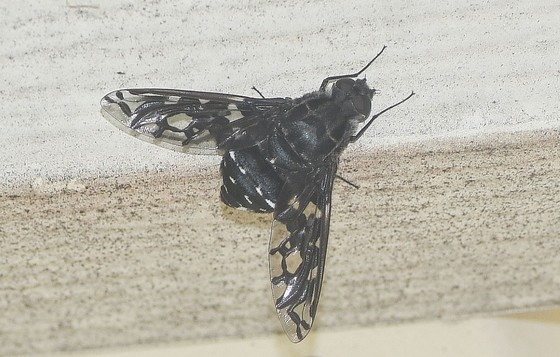 A close look reveals the tiger bee fly's stained glass-like wings (Terry W. Johnson)
By TERRY W. JOHNSON
Many Georgia homeowners are waging war with carpenter bees.
These native bees are hard-working pollinators, but they draw our ire because females bore holes up to 10 inches long in bare wood on our homes and decks to lay eggs.
People use a number of techniques to thwart carpenter bees, swatting and trapping them, dousing woodwork with citrus sprays, plugging their holes with steel wool, even playing loud music near nests.
But what most don’t realize is they have a wild ally that works diligently throughout the warm months to rein in the pesky bees. This natural control agent is a fly that packs a bee-sized punch.
Meet the tiger bee fly. …
Read Terry’s column to learn about these amazing flies and how to attract them.
Terry W. Johnson is a retired DNR program manager and executive director of TERN, the Wildlife Conservation Section’s friends group. Read past columns, his Backyard Wildlife Connection blog and book “A Journey of Discovery: Monroe County Outdoors.” (Permission is required to reprint this column.)
Top
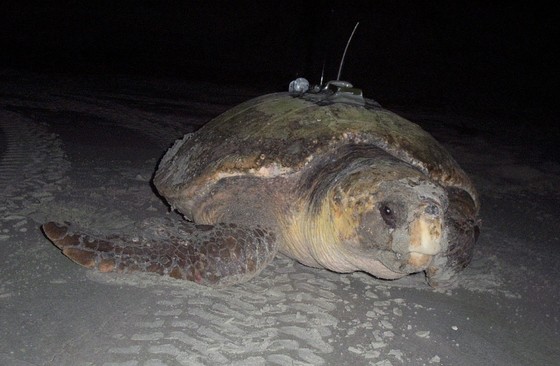 Toting a transmitter, Georgia is ready for release in 2005. (DNR)
By LANIER FORSTER
Georgia, the state, has shattered its nesting record for loggerhead sea turtles with more than 3,780 nests (the previous high: 3,289 in 2016). And the season isn’t over.
Georgia, the mama loggerhead, deserves some credit for reaching this milestone.
Georgia’s nests have been logged through genetic research with the University of Georgia. Using one egg collected from every clutch, UGA extracts maternal DNA that can be used to identify the female that made the nest. This enables scientists to determine how often and where she nests. Data from all nests is extrapolated to estimate the size of the loggerhead population and survival rates.
But Georgia has played an even more significant role in helping researchers understand more about her species' biology. In 2005 she was fitted with radio and sonic transmitters in a study aimed at understanding the movements of female loggerheads.
She went on to lay four nests on Sapelo and Blackbeard islands that season and has returned six times since, contributing a total of 30 nests.
In between laying eggs – a clutch about every 12 days – Georgia often relaxes near the ballast rock pile at the north end of Blackbeard. Yet as soon as she finishes nesting, she’s off to the Virginia coast for the rest of the summer. When the weather cools, she swims south to the edge of the Gulf Stream off North Carolina for winter.
Although her satellite transmitter played out after about a year, researchers have followed Georgia through genetic tracking from her nests. She nests about every two to three years, always on Sapelo or Blackbeard.
After nesting in 2018, however, Georgia returned to nest again this year, which is highly unusual for sea turtles because of the extreme amount of energy expended during nesting.
Or maybe it’s just another example of this loggerhead doing more than her share.
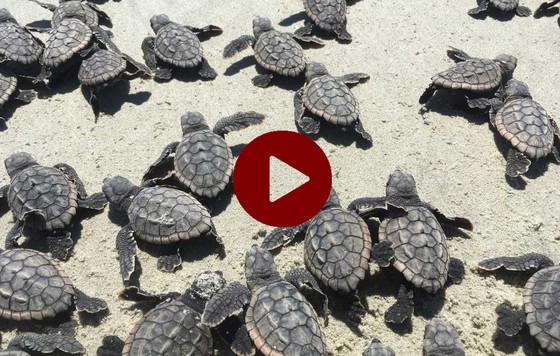 A rare full daytime hatch of a nest on Ossabaw Island (Ashley Raybould/DNR)
SEA TURTLE UPDATES
Follow nesting and hatching daily at seaturtle.org.
Lanier Forster works with DNR Public Affairs and is a graduate student in UGA’s Grady College of Journalism and Mass Communication.
Top
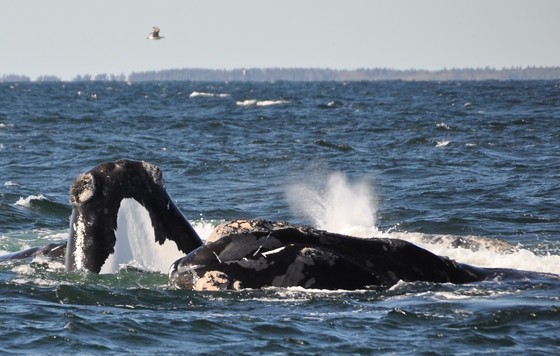 North Atlantic right whales in Canada (Jolinne Surrette/Fisheries and Oceans Canada)
Two more North Atlantic right whales have been found dead in the Gulf of St. Lawrence. That makes eight confirmed dead this year in Canadian waters, plus three entangled in commercial fishing gear (two have been partially freed). This ongoing “unusual mortality event,” which dates to 2017 when 17 dead right whales turned up in Canada and the U.S., and subaverage calving off the Georgia/north Florida coast since 2010 (“Calf count doesn’t ease concerns,” April 12) are undermining the already precarious outlook for these endangered whales.
Recovering America’s Wildlife Act, introduced in Congress this month, would dedicate some $30 million to conserving Georgia animal and plant species listed as a high priority for conservation in the state's Wildlife Action Plan. Called a game-changer for wildlife, the bipartisan House Resolution 3742, cosponsored by U.S. Rep. Austin Scott of Tifton, would provide $1.4 billion nationwide to state and tribal wildlife agencies to restore and monitor at-risk species.
Georgia teachers, from professional educators to moms and dads, can find what they need to instruct their students and families in the outdoors at the DNR Wildlife Resources Division’s new education web portal. Resources range from species profiles and educational videos to camps and events.
Top
 One-week-old blind salamander (Danté Fenolio/San Antonio Zoo)
Georgia blind salamanders have been bred for the first time in captivity, a success at the San Antonio Zoo that could help conserve the imperiled amphibians. The breakthrough is rooted in research authorized by DNR and Florida to explore the distribution and status of blind salamanders and Dougherty Plain crayfish, elusive inhabitants of the Floridan aquifer (“Parting shots,” Sept. 29, 2014).
What does September make you think of? How about growing native plants for birds, which is what the month has been proclaimed by Gov. Brian Kemp, thanks to a collaboration between Atlanta Audubon Society and the Georgia Native Plant Society. Related events.
About 20 volunteers from Takeda Pharmaceutical Co. recently helped clean up around ponds at Charlie Elliott Wildlife Center, gathering bags of litter, tires, fishing line and even a trash can. Find out how to volunteer with DNR’s Wildlife Resources Division.
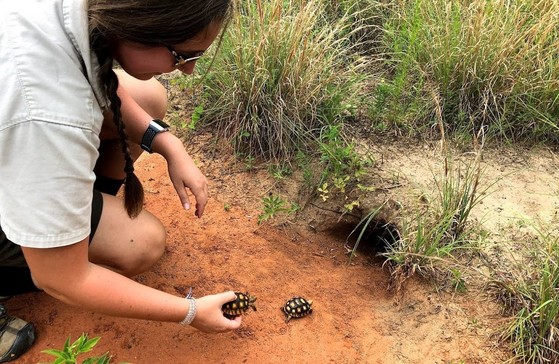 Fish and Wildlife's Jessica Radich releases head-started tortoises at Lanahassee (Ashley Bohle/WALB-TV)
Gopher tortoises at Lanahassee Creek Voluntary Public Access saw an influx of neighbors recently with the release of about 60 juveniles raised from eggs at Warm Springs National Fish Hatchery. The hope is the head-started reptiles, along with local tortoises and 63 adults moved there last year from development sites, help create a viable population of gophers at the west Georgia conservation area.
Bass anglers can land their name and catches in two unique DNR programs. Georgia Bass Slam recognizes anglers who catch five of the state’s 10 black bass species in a calendar year, while Trophy Bass Angler Awards focuses on lunkers of 10 pounds or more. (And when fishing the coast, join DNR's Saltwater Slam!)
Blue-ribbon winners announced at this year’s Association of Conservation Information conference included DNR’s Facebook post on native snakes (post of the year), Georgia Wild (external newsletter) and the “Be Bear Wise This Summer” video (video public service announcement). Senior wildlife biologist Nathan Klaus was featured in the second-place news release and the third-place education entry “Woodland Wonders at Tallulah Gorge.” DNR also placed second in online engagement with an Instagram Ask a Biologist series and third in website (Wildlife Resources Division website) and external newsletter (Go Hunt e-news).
Top
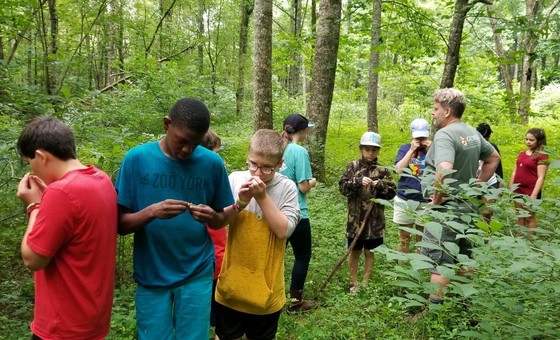 DNR's Mincy Moffett Jr. leads the Sci-Fries on a north Georgia hike (Deanna Ryan/Swainsboro Middle School)
In a far-reaching field trip, the Swainsboro Middle School Science Club Sci-Fries visited north Georgia stops including the State Botanical Garden of Georgia, Tallulah Gorge State Park and, guided by DNR, a mountain bog. DNR has been involved with the group led by teacher Deanna Ryan for more than 10 years, mostly involving outreach on Ohoopee Dunes Wildlife Management Area.
Tick numbers take a hit in areas treated with prescribed fire long-term, research has shown. But a new study in the journal Nature reveals another upside: The rate at which ticks carrying pathogens are encountered drops as much as 98 percent on burned sites, meaning there’s less risk of transmission and infection.
Names in the news: The July/August issue of the children’s science magazine Muse features a Q&A with DNR fire management officer Shan Cammack, written by fellow wildlife biologist Anna Yellin. Environmental outreach coordinator Linda May recently taught water ecology to a group of Junior Ranger campers and adults at Hard Labor Creek State Park, using animals varying from dragonfly nymphs to crayfish netted in Lake Brantley.
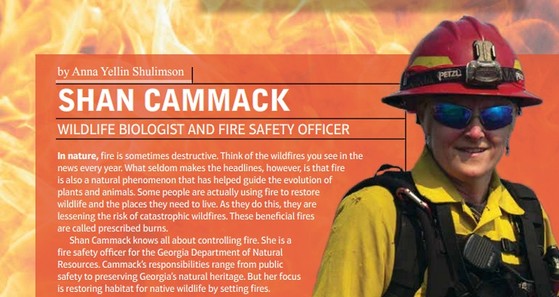 A copy of the Shan Cammack Q&A is provided with permission from Muse Magazine, © 2019 by Cricket Media.
UPCOMING
July 30-31 – DNR workshop for 2019-2020 Georgia Outdoor Stewardship and Georgia Recreational Trails program grants, Ft. McAllister State Park, Richmond Hill. Also: Aug. 1-2, Little Ocmulgee State Park, McRae. Registration required.
Aug. 1-3 – 2nd Annual Wild & Scenic Film Festival, Columbus State University Riverside Theater, Columbus
Aug. 10 – "Black Bear Myths and Relationships," 11 a.m., Brasstown Bald
WHAT YOU MISSED …
In the previous Georgia Wild:
- Loggerheads' breakout year
- A champ for Georgia plants
- Rare bird rebounds at Silver Lake
- Backyard pearls with wings
- You can't keep a good raptor down
Top
"Sprewell Bluff: managing without boundaries," The Longleaf Leader. Also: articles on Pasley River Farm and the West-central Georgia Landowner Assistance Program
"Dramatic video shows Georgia beachgoers rescuing beached whales," CBS News. Also: The New York Times, others.
"DNR announces $1,000 grant for top conservation teacher," The (Bainbridge) Post Searchlight
"Sea turtles run up score in nesting," The Brunswick News, and others via AP
"Explore water world of old-growth forest (Miller Lake)," Savannah Morning News
"Officials work to ID dead right whale, warn of more fatalities," The (Toronto) Star. Also: "Four mother-calf pairs in Gulf of St. Lawrence," Canada Broadcasting Corp.
"Georgia Power, others embrace honeybees," U.S. Fish and Wildlife Service
"Eagles survived Michael, fewer hatchlings in nests," SaportaReport. Also: Covington News, WJCL-TV (Ch. 22, Savannah)
"Bringing back rich grasslands of the Southeast," Yale Environment 360
"Right whales get relief from planned halt of oil exploration," Saporta Report
"Endangered woodpeckers causing big stir in S.C.," Greenville (S.C.) News
"The most harmful snake is the one you mess with," WRDW-TV (Ch. 12, Augusta)
"Cumberland Island wildlife fire contained," National Park Service
"At 89, bird rehabber on Skidaway looks for successor," Savannah Morning News
"Texas’s Gulf Coast being battered by ‘nurdle’ pollution," Atlas Obscura
"In central Appalachia, a deal for the centuries," The Nature Conservancy
 VIDEO AND AUDIO
"Living rocks: freshwater mussels," including DNR's Ani Popp (above), National Fish and Wildlife Foundation
"Georgia's six venomous snake species," DNR
(audio) "First 'song' recorded from rare right whale off Alaska," Reuters
Juvenile osprey defends nest at The Landings, Landings Bird Cam
Top
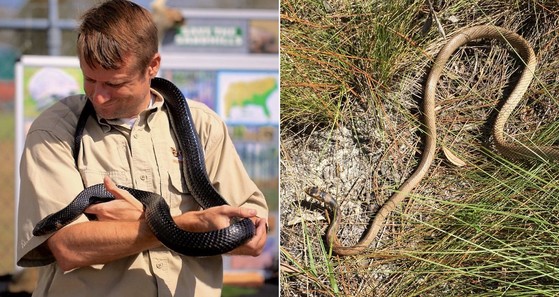 DNR's Matt Moore with an indigo; at right, an eastern coachwhip (Paul Evans; Aubrey Pawlikowski)
Q. A south Georgia resident wrote to question whether eastern indigo snakes are truly Georgia’s largest native snakes. He recalled seeing skeletons of coachwhips that he estimated at 8 feet or longer.
A. Wildlife biologist Thomas Floyd says that indigos rate as North America’s -- and thus, Georgia's -- largest snake based on documented specimens and published measurements. Floyd adds, however, that maximum lengths recorded for eastern coach whips, at 101.5 inches, are close to those of indigos, at 103.25 inches.
“No doubt, both species exhibit long specimens among their ranks.”
Body size is an additional characteristic considered in the largest designation. And while eastern indigos are generally stout-bodied snakes, weighing up to 11 or more pounds, coachwhips -- although long -- are more slender.
Got a Georgia wildlife question? Send it our way.
Top
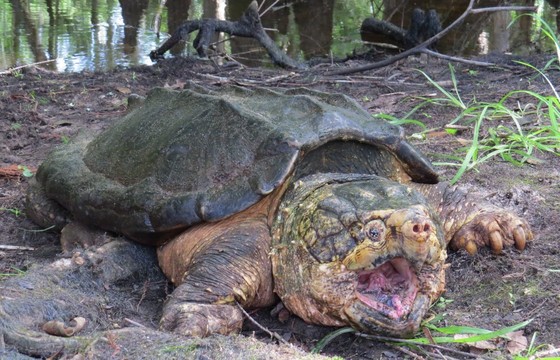 An 86-pound alligator snapper on the Willacoochee River (Dirk J. Stevenson/Altamaha Environmental Consulting)
Hoop-trap surveys helping determine the status and distribution of Suwannee alligator snapping turtles in Georgia netted 330 pounds of disgruntled snappers last month. The six captured and released turtles featured three males weighing 80 to 88 pounds each, plus an 8-pound youngster. Upstream records were set for Macrochelys suwanniensis on Okapilco Creek, a Withlacoochee River tributary, and on the Willacoochee River. Georgia is home to both alligator snapping turtle species, some of the world’s largest freshwater turtles. The Suwanee alligator snapper is found in the Suwannee River drainage. It’s kin, Macrochelys temminckii, inhabits the Apalachicola-Chattahoochee Flint River basin. Each is being considered for Endangered Species Act listing. For the two-year Georgia project, now in its second year (“Where monsters dwell,” Sept. 25), The Orianne Society and Altamaha Environmental Consulting are trapping, marking and tagging Suwanee snappers and recording details on their habitat. The surveys will continue through summer. There are fewer than 50 documented occurrences of Suwanee snappers in Georgia.
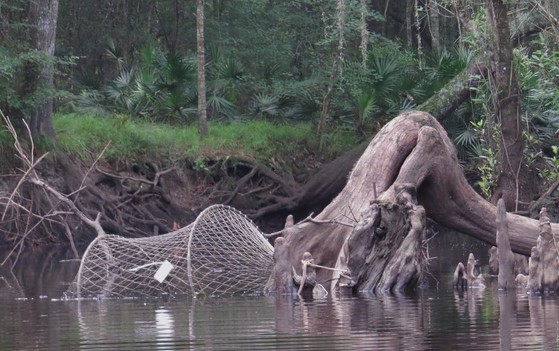 Trapping a promising site for gator snapping turtles (Dirk J. Stevenson/Altamaha Environmental Consulting)
CREDITS
Masthead: Pilot whale pod swimming to deeper water off St. Simons Island July 17 (National Marine Mammal Foundation/NOAA permit 18786-03)
Northern pine snake (John Jensen/DNR)
Top
|